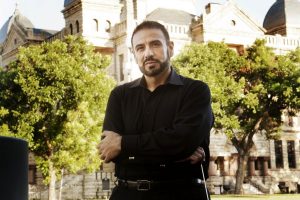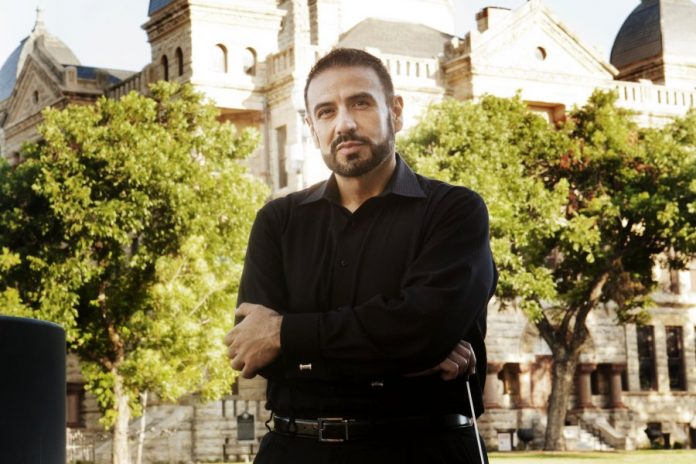
Dr. Arturo Ortega will pick up the conductor’s baton to lead the Voices of Flower Mound (VFM) community chorus, founded a decade ago.
His musical journey to the conducting podium began when he was age five.
“I started guitar lessons, but was transfixed by the piano that sat in my teacher’s studio,” he said.
As events unfolded, Ortega became a piano student and then he took that skill into his high school band percussion section. Pianos fit into the percussion instrument category, because each key moves a small hammer that strikes a harp string inside the big instrument’s wood chassis.
Ortega, who hails from Laredo, came to the University of North Texas (UNT) music school via San Antonio, and is a rising name on the international musical stage.
Ortega has supervised the acquisition and processing of musical scores at the UNT Music School library and also guest-conducted major orchestras and choruses in Atlanta, Mexico City, Argentina, Singapore and London.
He has been an Associate Conductor with the Denton Symphony and its chamber orchestras, directs music in Denton Community Theater productions and the 40-plus member Robson Ranch Chorus.
Last season, members of the group liked what they saw of Ortega at a Robson Ranch performance. After founding conductor Mary McGuyer announced her departure in June, the VFM board approached him about filling its empty conducting position.
VFM consists of people in southern Denton County who like to sing, are willing to commit to a two-hour rehearsal each week and, of course, perform together a couple of times each year.
“The important thing is for individuals to strive for improvement at each rehearsal,” Ortega said. “And, of course, community singing should be fun.”
The Robson Ranch Chorus does three concerts a year: Spring, Veterans’ Day and Christmas. Similarly, VFM does Spring, Fall, Christmas and some performances with the Flower Mound Symphony Orchestra, which is at home at Trietsch United Methodist Church in Flower Mound.
Even though Ortega specializes in post-Romantic and 20th Century symphonic music, he is not afraid of popular American hits from the 1950s through the 1970s.
“At Robson Ranch we did pop, rock ‘n’ roll, doo-wop and toe tappers,” he said.
How did this man of such wide musical tastes enter the post-romantic symphonic world of composers such as Shostakovich and Mahler?
“At age fifteen I got involved in percussion with the Laredo Philharmonic Orchestra,” said Ortega “The conductor, Terence Frazor, encouraged my interest in leading the rehearsing performers and sometimes he let me take the podium, while he stood at the rear of the hall listening to the orchestra.”
Frazor was also a director at the New School of Music in New York City, which constitutes the where, when and how of Ortega’s first taste of reading and interpreting musical scores; the big book containing all the lines of notes to be played by each member of the orchestra. Conductors spread the score across the podium, and refer to it as they listen and direct the full array of instruments.
“Since childhood, I have always thought about interpretation– the meaning– of music I heard,” he said. “The conductor not only gets to choose his group’s music for performance, but he decides how they will play it.”
To play footloose with an old proverb, the conductor is the Chief, and the instrumentalists are the Indians.
After high school graduation, Ortega enrolled as a pre-med student at Saint Mary’s University in San Antonio.
“I was the only musician in my immediate family, and felt it was time to move on into the real career world,” he said. “But, the Music Department ‘magnet’ always tugged at me.”
Two years later, he changed his major to music and became involved as a percussionist at the San Antonio Symphony Orchestra, where Christopher Wilkins was the Music Director and conductor.
In connection with Saint Mary’s, he attended the Texas Music Educators Association (TMEA) annual convention that featured the University of North Texas (UNT) Symphony Orchestra.
“I fell in love,” he said.
Transferring to UNT, Ortega continued the musical love affair by becoming the only undergraduate enrolled in Anshel Brusilow’s (say ahn-shel broo-si-lohv) graduate school studio for conductors.
Before settling in on the music faculty at UNT, Brusilow had been the Concertmaster, the chief violinist, of the Philadelphia, Cleveland and Dallas orchestras.
The association with Brusilow led Ortega to training under Charles Bruck at the prestigious Pierre Monteux School of Conductors at Hancock, Maine, and an Assistant Conductor audition with the Chicago Symphony Orchestra. Ortega became one of the two finalists.
In 2002, Ortega received his Doctor of Musical Arts diploma from UNT.
So, what does a conductor do besides swing a baton to indicate the tempo of a piece of music?
“He communicates with the musicians through a set of known gestures,” said Ortega. “He and the players read and follow the same notation. He directs the volume, length, speed and phrasing of all the sounds.”
The conductor is in charge of leading the orchestra to convey what the composition has to say to the audience. Music, like any language, has single tones and groups of them. We might compare it to alphabet letters, words, phrases, sentences, paragraphs and whole ideas called themes. Our own times speak to the idea that music is a nonverbal art, in which acoustic patterns may transmit meaning and tone.
The ancient Greeks thought music ought to reflect divine harmony and moral orderliness. This idea is still with us in many cultural quarters. One ancient thinker, Empiricus, argued that music was the art of arranging tones and rhythms, without reference to morality.
The argument can be made that singing is probably the oldest musical activity on planet earth; being used first in the expression and renewal of cherished traditions. Western classical choral works often fall into this category.
What choruses are his ideal? Reach for the stars! The Dallas Symphony Chorus, the Atlanta Symphony Chorus, the Chicago Symphony Chorus– “and don’t forget the Mormon Tabernacle Choir.”
“Seek out the arts around you,” said Ortega. “A group of singers contains the sound complexity of an instrumental orchestra,” said Ortega. “Every voice has its unique texture. Take advantage of the vast beauty of music and take opportunities to be part of the community through its music.”
Choral music comes in the form of solos, duets and every other conceivable “et” up to the octet and then continues on for large groups with four basic voices: soprano, alto, tenor and bass. If you like to sing, and your voice falls into one of these categories, check out the VFM website at www.voicesofflowermound.com and arrange to let Ortega have a little listen.
“You don’t have to be a professional,” he said. “I am very excited to work with the Voices of Flower Mound.”









 GIF.gif)








